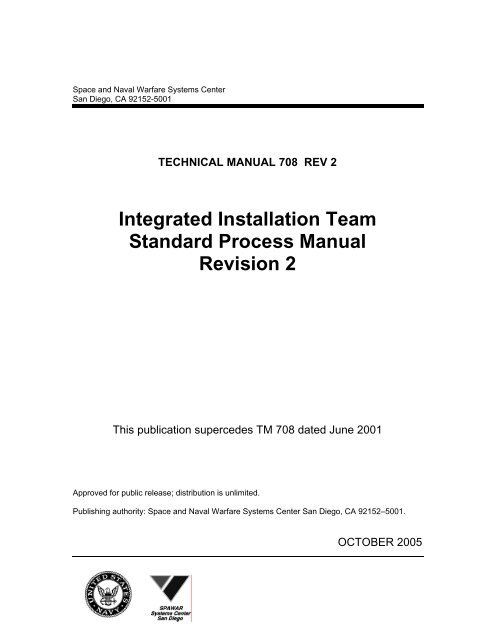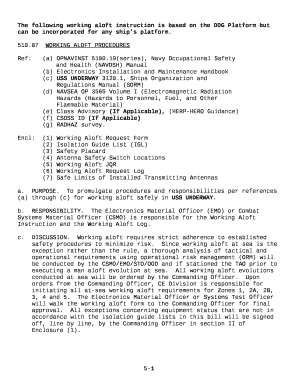NAVSEA, U.S. Fleet Forces Command and Commander Pacific Fleet have always worked to optimize the PMS and reduce burdensome processes upon sailors. Improvements such as Fleet Maintenance Effectiveness Review (FLEETMER) and SKED have been highly successful. In the late ‘90s, the Maintenance Effectiveness Review process was developed and used to review the PMS deck. These technical reviews helped to reduce unnecessary O-Level PMS procedures by 30% and ensured that required maintenance Sailors were performing was applicable and effective. Today’s FLEETMER process includes a review of the entire maintenance plan. Other initiatives included SKED which received positive feedback from the Fleet. More on that in a bit.
The Combat System Operational Sequencing System (CSOSS) is a collection of manuals specifically designed for each class of ship. The manuals include step-by-step procedures and supporting material for combat system personnel to use in supporting the operation and maintenance of combat system equipment. CSOSS Documentation. CSOP, CSOCC, Support Data. Combat System Operational Procedures - covers the normal light-off, testing, operation and securing of the. Each work center will have one with information about the system and compartment the work center owns in order to operate the system. Combat System Operational Perperation Procedures Covers normal light off, testing, operation, and securing of the combat system. The CSOS Subscriber Manual provides detailed step-by-step instructions for CSOS enrollment and Certificate retrieval in addition to documenting many aspects of Certificate management and security. Please note that this is a large file and may take a considerable amount of time to download using a low-speed/dial-up internet connection.
In the past year, NAVSEA and the Fleets kicked off a multi-year project to modernize and improve the PMS program. It’s called the Future of PMS (FoPMS) and its ultimate goal is to form a cohesive PMS program that leverages automation and process streamlining to reduce administrative burden and support sailors in effectively maintaining the Fleet. This modernized system is an evolution of existing programs that will transform PMS from a paper based system to digitally-enabled with enhanced workflows, data reporting and near real-time distribution of technical requirements. A brighter future is ahead for Navy PMS but it is important to look at those programs that came before and are setting the foundation for FoPMS.

SKED, the Navy’s PMS scheduling software was born in the late ‘90s when personal computers began to be outfitted on ships. The earliest versions were a bit clunky to use but did alleviate some of the paper work. As SKED was refined, version 3.1 became mandatory to use across the Fleet in 2004. SKED 3.2, introduced in 2008, was developed and deployed to provide a modern configuration centric process. Recent updates to SKED include Leadership dashboards, equipment based schedules, true interval scheduling, situational maintenance scheduling improvements and electronic lineouts, approvals and workflows. Future versions of SKED will continue to improve with features like custom views and reports, flexible PMS checks, accomplishment rating enhancements, and managing Advance Change Notices within SKED. Improvements for distributed commands such as LCS and NECC are also in the works.
Another toolset whose data will be incorporated into FoPMS is the Tailored Force Revision (TFR). Deployed in 2010, TFR Packages reduce the administrative burden of implementing PMS changes by performing up to 70% of the work ashore before being sent to the ship. It’s an enhanced Force Revision (FR) package tailored to each Work Center Supervisor (WCS). The Tailored Force Revision has pre-processed FR data that a WCS can import into SKED. It also shows document/schedule changes and flags inconsistent items for review. TFR Packages are currently for surface ships only, but will be made for Air and Sub communities in 2018.

PMS Change Indicators and PMS Templates have been developed as a result of Tailored Force Revisions. Both will be assimilated into FoPMS. PMS Change Indicators appeared in 2013 and are used to highlight changes on MIP and MRC documents since the last FR, thus eliminating the need to print and manually compare old documents with new documents. PMS Templates will simplify MIPs by grouping MRCs to one kind of equipment or system essentially building equipment maintenance plans from shore and reducing lineouts. PMS Templates are the foundation for tying requirements to configuration. Pilot tests are occurring in 2015 starting with DDGs with a plan to distribute to the entire surface fleet in 2016.
One of the major goals for the FoPMS is Configuration-Based Maintenance. Right now, Work Center Supervisors have to sort through MIPs to line out procedures on equipment that do not apply to them. Started in 2012, the Configuration-based maintenance project breaks complex PMS documents into equipment-specific versions and eliminates the need for MIP and MRC procedure step line-outs and pen and ink lineouts. Configuration specific PMS documents are gradually being implemented and delivered to the Fleet with each FR.
All of these programs lead to the future, The Future of PMS. FoPMS is a modernization but also an evolution of the Navy’s Planned Maintenance System. It takes the best ideas and concepts from the past and melds them with new ideas and technologies. For example, FoPMS will see a modernization of SKED. Configuration based O-level Maintenance Plans will be provided from ashore with maintenance schedules that allow the Work Center Supervisor to easily assign resources and dates. SKED in the “future” will also provide optimal work load balancing tools, 3M Inspection tools and the ability to consume the collection of material condition data.
Also, to truly modernize Navy PMS, it is necessary to take the current paper based system and digitize it. Right now, sailors read instructions off of 8” X 11” paper. With FoPMS, procedures will have the ability to be read on mobile devices like tablets. In order to make the most of these mobile tools, the modernized system will have enhanced PMS Data Content and features with near real time updates to keep procedures current and eliminate the need to make pen and ink changes. Not only will their procedures be the most current but they will support point of performance tools like videos that demonstrate exactly how a maintenance step is done.

Updating policy is key to the Future of PMS project. In 2014, two important entities were created to evaluate and approve policy changes that will shape FoPMS: the U.S. Fleet Forces Command 3-M Requirements Management Board (RMB) and NAVSEA’s 3-M Configuration Control Board (CCB). Basically, the RMB will identify and recommend policy changes to the CCB who will then review and approve changes. This establishes a governing body for the Future of PMS and benefits sailors a number of ways:

- Policy changes are made more quickly
- All 3M policy will be standardized and aligned
- Administrative burdens such as printing requirements are reduced
- Communication with sailors is increased
The Future of PMS is real. However, it couldn’t happen without the programs that came before it and the current initiatives that are building towards its creation. It is a six year mission in progress and it won’t stop until all the goals are accomplished. Of course, fifty years of Navy PMS couldn’t have happened without the guidance, hard work and input from the many men and women who served.

American Red Cross Manual Pdf
This holds true today. As we look towards the modernization of PMS, we want to hear from the many sailors whose opinions are so vital. While this was just a quick look at the Future of PMS, more information can be found at a devoted PMS milSuite site where you can see updates, videos and provide your thoughts. Just go to https://www.milsuite.mil and search Reinvigorating Shipboard PMS. You can also email your ideas to pms@navy.mil. Your perspective will keep the Future of PMS headed in the right direction.
Red Cross Manual Download
